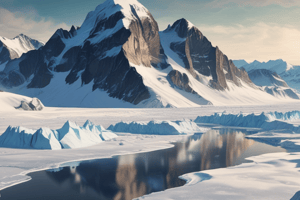Podcast
Questions and Answers
A ______ moraine forms along the sides of a glacier.
A ______ moraine forms along the sides of a glacier.
lateral
A layer of till deposited beneath the glacier as it moves is called a ______ moraine.
A layer of till deposited beneath the glacier as it moves is called a ______ moraine.
ground
Glaciers can create a jagged landscape through a process known as ______.
Glaciers can create a jagged landscape through a process known as ______.
plucking
A streamlined, elongated hill composed of glacial till is called a ______.
A streamlined, elongated hill composed of glacial till is called a ______.
Large boulders transported by a glacier are referred to as ______ rocks.
Large boulders transported by a glacier are referred to as ______ rocks.
The process where debris and rocks embedded in ice grind against the bedrock is known as ______.
The process where debris and rocks embedded in ice grind against the bedrock is known as ______.
Freeze-thaw weathering is also known as ______ action.
Freeze-thaw weathering is also known as ______ action.
Glaciers transport vast amounts of rock and debris over long ______.
Glaciers transport vast amounts of rock and debris over long ______.
The expansion of ______ exerts pressure on rock, causing it to crack.
The expansion of ______ exerts pressure on rock, causing it to crack.
The process creates striations and ______ flour as a glacier moves.
The process creates striations and ______ flour as a glacier moves.
Flashcards are hidden until you start studying
Study Notes
Glacier Transport and Deposition
- Glaciers carry debris and rocks on their surfaces, originating from rockfalls, avalanches, and wind-blown sediment.
- Debris within glaciers often falls into crevasses or gets buried by snow and ice buildup, contributing to transport.
- At the glacier's base, debris, including plucked rocks and sediment, is dragged along, causing erosion through grinding against bedrock.
Types of Glacial Deposits
- Till: Unsorted debris directly deposited by melting glaciers, forming moraines and other features.
- Moraines: Accumulations of till creating ridges or mounds; types include lateral, medial, terminal, and ground moraines.
- Drumlins: Elongated hills of glacial till shaped by glacier movement, indicating ice flow direction.
- Erratics: Large boulders transported by glaciers from their source, notable for differing local rock compositions.
Glacier Formation and Characteristics
- Glaciers develop in areas with more snowfall in winter than melting in summer, leading to ice and snow accumulation.
- A glacier is a large, slow-moving mass of ice formed from compacted snow layers.
Valley Types Shaped by Glaciers
- U-Shaped Valley: Result of glacial erosion widening and deepening a pre-existing V-shaped valley, characterized by steep sides and a flat floor.
- V-Shaped Valley: Formed by river erosion, features steep sides and a narrow, winding floor.
- Hanging Valley: Smaller side valleys that meet the main glacier at higher elevations, created by less deep erosion from tributary glaciers.
Geomorphological Features Created by Glaciers
- Corrie (Cirque): Amphitheater-shaped hollows at glacier heads formed by erosion and freeze-thaw weathering.
- Pyramidal Peak: Pointed mountain formed by erosion from multiple corries surrounding a central point.
- Arête: Sharp, narrow ridges created by glaciers eroding rock between two corries or glacial valleys.
Erosional Processes
- Erosion: Glaciers reshape landscapes through abrasion, plucking, and freeze-thaw weathering.
- Abrasion: Rocks and debris in ice act like sandpaper, smoothing bedrock and creating striations and rock flour.
- Plucking: Glaciers freeze onto rocks, pulling them away from the bedrock, creating a rugged landscape.
- Freeze-Thaw Weathering: Water seeps into rock cracks, freezes, expands, and causes rock fragmentation, especially prominent in colder regions.
Glacier Transport Mechanics
- Glaciers can transport significant volumes of rock and debris over vast distances, reshaping topography.
Studying That Suits You
Use AI to generate personalized quizzes and flashcards to suit your learning preferences.




